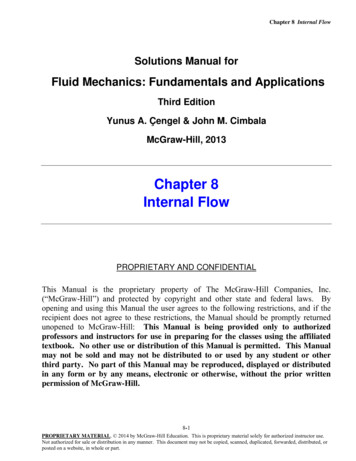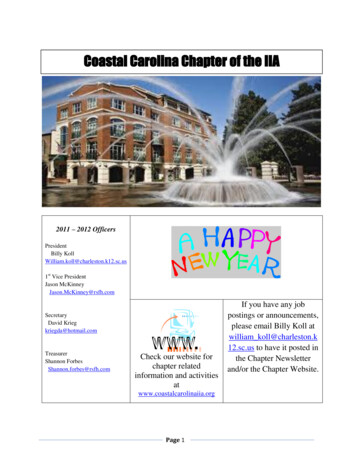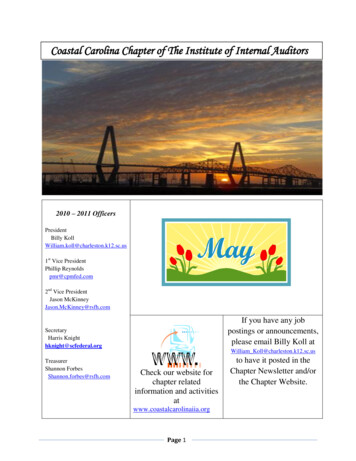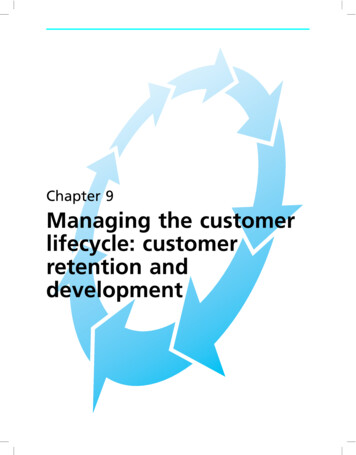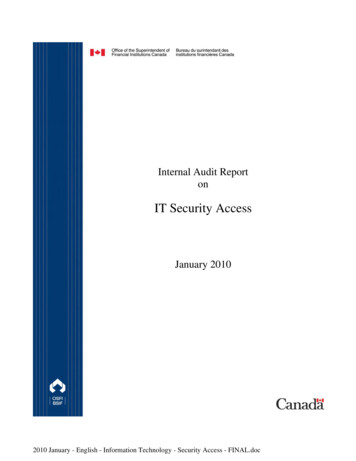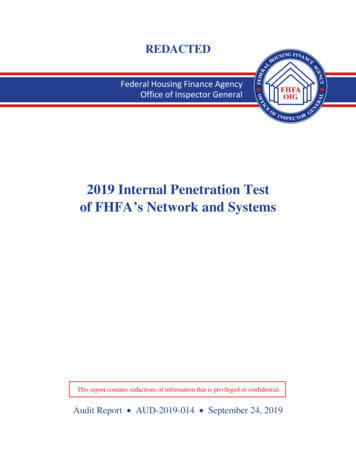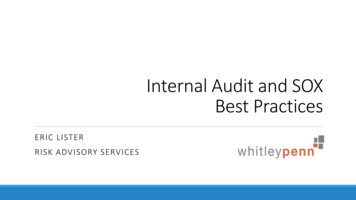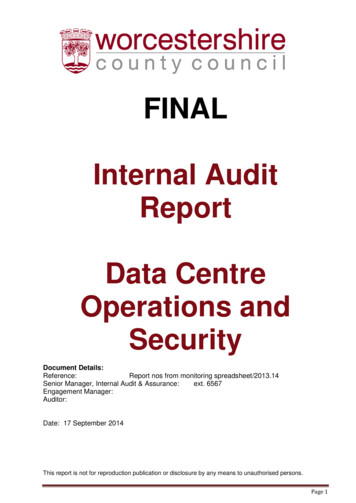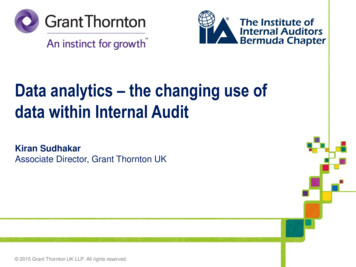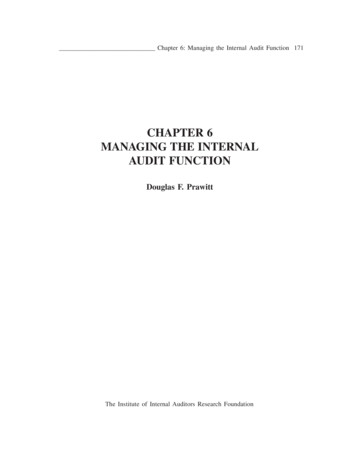
Transcription
Chapter 6: Managing the Internal Audit Function 171CHAPTER 6MANAGING THE INTERNALAUDIT FUNCTIONDouglas F. PrawittThe Institute of Internal Auditors Research Foundation
DisclosureCopyright 2003 by The Institute of Internal Auditors, 247 Maitland Avenue, Altamonte Springs, Florida32701-4201. All rights reserved. Printed in the United States of America. No part of this publication may bereproduced, stored in a retrieval system, or transmitted in any form by any means — electronic, mechanical,photocopying, recording, or otherwise — without prior written permission of the publisher.The IIA publishes this document for informational and educational purposes. This document is intendedto provide information, but is not a substitute for legal or accounting advice. The IIA does not provide suchadvice and makes no warranty as to any legal or accounting results through its publication of this document.When legal or accounting issues arise, professional assistance should be sought and retained.The Professional Practices Framework for Internal Auditing (PPF) was designed by The IIA Board of Directors’Guidance Task Force to appropriately organize the full range of existing and developing practice guidancefor the profession. Based on the definition of internal auditing, the PPF comprises Ethics and Standards,Practice Advisories, and Development and Practice Aids, and paves the way to world-class internal auditing.This guidance fits into the Framework under the heading Development and Practice Aids.ISBN 0-89413-498-102404 01/03First Printing
172 Research Opportunities in Internal AuditingI. IntroductionThis chapter discusses staffing and managing the internal audit function (IAF) as a componentof organizational governance, and has two main purposes. First, it familiarizes interestedpractitioners and researchers with current trends and issues in staffing and managing theIAF. Second, it suggests questions and topics for future thinking and research amongpractitioners and academics. Managing and staffing an IAF is a vast and complex undertakingthat remains relatively unexplored by rigorous research. The chapter contains several citationsto practitioner information and academic research, but it does not attempt to include acomprehensive literature review of all relevant articles or research. Rather, it is intended thatinterested readers use the references as a starting point in accessing other relevant information.Much of the research cited is found in other disciplines or in the external audit domain.While the external audit environment can usefully serve as a starting point in generatingresearchable ideas in internal auditing, the researcher must carefully take into account thesometimes subtle differences between the institutional and environmental features of internaland external auditing. In fact, if viewed appropriately, these differences offer fertile groundfor the generation of promising research questions.The organizing framework for the chapter is adapted from a widely accepted, fundamentalmodel of management (DuBrin, 1999, Dessler, 2000, and Griffen, 2002). The primarycomponents of that fundamental management model, and of this chapter, are planning,organizing, staffing, leading, and controlling.The planning section of this chapter discusses the issues involved in planning at theorganizational and individual engagement levels. The organizing section looks at organizingthe IAF at a company-wide level and then continues by analyzing the use of internal auditteams and the common practice of using the IAF as a management training ground. Staffingthe IAF is a significant part of the chapter. This section discusses the hiring, training, andstaffing of internal auditors as well as the use of task structure to make effective staffassignments. It also analyzes compensation and retention strategies of the IAF. The leadingsection discusses leadership and motivation issues. Finally, the controlling section discussesthe importance of ensuring the IAF is adding value to the organization.II. PlanningInternal Audit Planning at the Organizational LevelWhether the IAF is in-house or outsourced, the IAF should develop an understanding of therisks that may prevent the organization from achieving its objectives. Based on thisThe Institute of Internal Auditors Research Foundation
Chapter 6: Managing the Internal Audit Function 173understanding, the IAF should then plan its work to help measure and mitigate those risks.These responsibilities come as a natural result of the IAF’s role as an agent employed to helpensure that the organization accomplishes established objectives. However, the internalauditor’s role is unique because the internal auditor is an agent that monitors the actions ofanother agent (management), both of whom are employed by the same principal1 (Adams,1994).Internal auditing standards indicate that “the chief audit executive should establish riskbased plans to determine the priorities of the internal audit activity, consistent with theorganization’s goals” (Standard 2010). During the process of determining, monitoring, andmitigating the organization’s risks, the IAF may provide assurance or consulting services.Kinney outlines the process of risk assessment and risk management in Chapter 5.Traditionally, internal auditors have identified and assessed organizational objectives andrisks informally. However, there is an emerging trend for internal auditors to become moredeeply and actively involved in organizational risk management. As they become involvedin risk management it is essential that they obtain management and board input and feedback.For instance, some auditors conduct one to two-day seminars together with key managementpersonnel. During this session, the participants attempt to determine key business driversand objectives, and the obstacles that may prevent management from utilizing these driversand accomplishing their objectives. Armed with this knowledge, internal audit leaders canestablish an internal audit plan that addresses the organization’s needs (Homer and Holdren,2001). Techniques such as these seminars, which capture the real-time needs of theorganization, help the IAF fulfill its corporate governance responsibilities. Seminars andother techniques (interviews, surveys, etc.) are often conducted on a predetermined timeschedule that allows auditors to continuously align the internal audit plan with theorganization’s objectives (LaTorre, 2002). Other auditors establish risk databases that catalogproducts and processes along with their associated risks, and some IAFs even use complexalgorithms to identify and calculate the organization’s level of risk (Leithhead and McNamee,2000).One important area that internal auditors may be called upon to assess and improve is the“tone at the top.” Tone at the top is a basic component of the COSO Internal Control frameworkand its importance has been highlighted by recent high profile business failures and fraudsperpetrated by top management. Boards can enlist the help of the IAF to ensure that the toneat the top is appropriate and effectively communicated to all levels of the organization(PricewaterhouseCoopers, 2002).Once the organization’s risks have been identified, internal auditors and management canalso work together to develop, evaluate, and improve internal controls to mitigate exposureThe Institute of Internal Auditors Research Foundation
174 Research Opportunities in Internal Auditingto risk. Control self-assessment (CSA) is a tool internal auditors use to involve managementand other employees in these processes. CSA requires internal auditors to become auditfacilitators by helping employees identify and monitor control areas that are important inensuring that business objectives are met (Morris, 2001). While internal auditors havetraditionally focused on providing assurance services aimed at mitigating risk, they haveincreasingly begun to deliver a variety of consulting services that assist clients in developingsolutions to mitigate risks. As internal auditors develop their skills in this area, relatedconsulting services are becoming a significant component of internal audit work. This trendhighlights the tension that may exist as internal auditors serve the board by assuring thatrisks are being identified and as they serve management by helping to develop proceduresthat mitigate these risks. This tension is discussed in detail in Chapter 4 of this report.Academic ResearchAs indicated in many other sections of this chapter, external audit research providesresearchers with a potential starting point in examining issues related to internal audit planning.Among many other planning issues examined in the external audit realm, researchers haveattempted to determine how varying levels of inherent risk can affect auditors’ risk assessment,generation of hypotheses, and justification of audit programs (Wright and Bedard, 2000).These issues are also found in internal auditing when identifying risks at the organizationaland individual engagement level. (See subsequent section for a discussion of engagementplanning.) Researchers should identify differences between the external and internal auditplanning environments, tasks, etc., and explore these differences to identify relevant researchtopics in internal auditing.Research Questions How do internal audit plans identify and attempt to mitigate organizational risks? In helping management identify organizational risks, what internal auditorcharacteristics, heuristics, and background lead to more effective risk assessment? External auditors are commonly emphasizing a top-down, broad-based view of riskassessment. How is the focus of internal auditors different from that of externalauditors in identifying organizational risk? Are internal auditors better or worse atidentifying organizational risk than external auditors? Why? What training techniques, if any, can help internal auditors gain the ability toeffectively identify organizational risks?The Institute of Internal Auditors Research Foundation
Chapter 6: Managing the Internal Audit Function 175 How does planning for IAFs that perform a significant amount of consulting workdiffer from planning for IAFs that perform primarily assurance work? How does the IAF/management relationship vary across countries and cultures?Planning Individual EngagementsIn addition to developing an organization-wide audit plan, “internal auditors should developand record a plan for each engagement” (Standard 2200). The IIA’s Standards for theProfessional Practice of Internal Auditing (Standards) also require that auditors consider theobjective and scope of each engagement in developing the engagement plan.In developing the engagement plan, auditors must ensure that the assurance/consultingengagement is designed to meet the objectives of the internal audit plan. If the internal auditengagement has been properly engineered, it will in turn contribute to ensuring that theorganization’s risks have been identified and appropriately controlled. The engagementplan will vary across engagements, but similarities will likely exist among similar types ofengagements, such as financial audit engagements, operational audit engagements, andconsulting engagements. Researchers can analyze the components that make these differentengagement plans effective.In order to improve the likelihood of a successful engagement, internal auditors can obtainmanagement’s cooperation early in the planning process by emphasizing that their purposeis to assist management in adding value to their divisions or departments and by asking themanagers to sign off on planning documents prior to beginning the engagement or service(Hubbard, 2000). Additionally, internal auditors can conduct preliminary engagementplanning several months in advance of the actual assurance or consulting work. Lemon andTatum include a discussion in their chapter addressing the importance of effective planningin internal audit engagements.Another important part of planning the engagement is assigning knowledgeable auditorswith relevant experience to each engagement. Experienced, knowledgeable auditors aremore likely to gain the confidence of the employees whose area they audit. IA managersmust also comply with the Standards by assigning auditors who can act independently andobjectively. Effective staffing for a particular engagement may require the IAF to outsourcepersonnel from professional services firms who possess the skills needed to complete anengagement. Additionally, the IAF can bring in people from within the organization, butoutside the internal audit department — a practice known as “insourcing.” Insourcing andoutsourcing should be planned well in advance and may be particularly relevant forThe Institute of Internal Auditors Research Foundation
176 Research Opportunities in Internal Auditingengagements that require auditors to possess technological or otherwise specialized knowledgeand skills (Hubbard, 2000). While staffing is an important part of planning the engagement,the staffing section of this chapter will further discuss the importance of appropriate staffingassignments.Engagement plans should also include an estimate of the cost of the engagement, specificrequirements for the number of auditors needed, and the skills these auditors should possess.The plans should then contain a detailed schedule of how long the engagement will last andhow the results of the engagement will be reported. Some engagements are designed toprovide explicit assurance while others provide implicit assurance.Academic ResearchResearch has been conducted in the external audit environment to evaluate auditors’ planningactivities, such as auditors’ assessments of inherent and control risk and the use of analyticalprocedures (Waller, 1993, and Biggs et al., 1995). Additionally, researchers have attemptedto determine the returns to planning. For instance, Davidson
teams and the common practice of using the IAF as a management training ground. Staffing the IAF is a significant part of the chapter. This section discusses the hiring, training, and staffing of internal auditors as well as the use of task structure to make effective staff assignments. It also analyzes compensation and retention strategies of the IAF. The leading section discusses leadership .File Size: 224KBPage Count: 60

